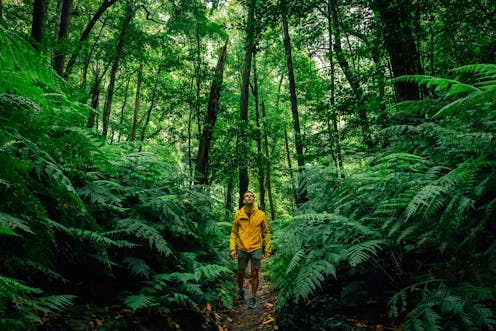Do humans really need other species?
- Written by Tom Langen, Professor of Biology, Clarkson University

Animals of all sizes, from tiny ants to enormous elephants, also move seeds, spreading plants[13] that make for healthy and productive ecosystems. Diverse species, from tiny microbes to huge vultures and sharks, break down dead organisms[14] into chemicals that can be used to grow more food.
The number of species that contribute to creating each bite of the average meal is mind-boggling.
Human bodies need other species to stay healthy
Many functions of the human body itself rely on a complex and highly diverse ecosystem of microbial species that live on the skin and in the respiratory, digestive and reproductive systems. These bacteria, fungi and other microbes are called a “microbiome[15].”
Each person has a unique personal microbiome to protect against infection, digest and extract nutrients in food[16] and synthesize vitamins.
For example, the gut microbiome is important for breaking down food into usable energy and nutrients, and converting other indigestible or toxic substances into forms that can be excreted.
This microbiome changes over people’s lifetimes based on what they eat, what’s around them, where they live and how healthy they are. In fact, human bodies are made up of more bacterial cells than human cells[17].
Diet and drugs strongly affect the 300 to 500 bacteria species that are the core of a healthy gut ecosystem[18].
The microbiome also plays an important role in preventing infection. Many diseases are associated with microbial communities that are dominated by just a few species[19]. Some physicians transplant poop from healthy to ill people[20] to establish a healthy community of microbes and hopefully cure the disease.
Humans are happier around other species
Finally, research shows that people are healthier and more content when they are around other species[21] of plants and animals. They need to experience the sights, sounds, smells, feel and taste[22] of other organisms for mental and physical health. This drive is called “biophilia,” meaning love of living things.
For example, seeing and hearing birds creates positive feelings. Two recent studies in Canada and Germany found that the more species of birds[23] in a neighborhood, the happier people are[24]. This may be due to experiencing the birds themselves, or due to a healthy environment, as indicated by the presence of birds.
In a different Canadian experiment, researchers played birdsong from hidden speakers along hiking trails. People reported that they felt more restored and were more satisfied[25] about the hike when they heard a diversity of birds species than when they heard few or none.
Today, more than half the world’s population lives in cities[26] instead of the countryside. So urban planners and landscape architects are exploring ways to include more green spaces and green infrastructure[27] in cities.
Research shows that when a city has diverse wildlife, ample open green space and vegetation[28] along streets and on buildings, people are more active, less stressed, healthier and happier. These conditions provide opportunities for people to experience and interact with other organisms[29], as well as benefit from the other things that plants, animals and microbes do to make the environment healthy and pleasant.
Scientists now know that it takes thousands of species to support human life. Yet we are only just beginning to understand the important roles different species play in ecosystems[30], including urban ones. We still need to learn much more about why and how other species are necessary for human survival. And if people are to successfully travel for long periods in space or establish space colonies, we will have to understand what species we need to take along with us to survive and prosper.
Hello, curious kids! Do you have a question you’d like an expert to answer? Ask an adult to send your question to CuriousKidsUS@theconversation.com[31]. Please tell us your name, age and the city where you live.
And since curiosity has no age limit – adults, let us know what you’re wondering, too. We won’t be able to answer every question, but we will do our best.
References
- ^ Curious Kids (theconversation.com)
- ^ curiouskidsus@theconversation.com (theconversation.com)
- ^ As an ecologist (scholar.google.com)
- ^ use energy from sunlight, water and carbon dioxide (www.nature.com)
- ^ This process is called photosynthesis (education.nationalgeographic.org)
- ^ make molecules that could be used for food (doi.org)
- ^ using genetically modified bacteria or cultured cell lines (doi.org)
- ^ create healthy soil (www.nrcs.usda.gov)
- ^ breathable air (doi.org)
- ^ that other organisms need to grow and thrive (www.youtube.com)
- ^ depend on pollinators to produce the fruit or seed (www.pollinator.org)
- ^ krisanapong detraphiphat/Moment via Getty Images (www.gettyimages.com)
- ^ move seeds, spreading plants (theconversation.com)
- ^ break down dead organisms (www.pbs.org)
- ^ microbiome (www.youtube.com)
- ^ digest and extract nutrients in food (theconversation.com)
- ^ are made up of more bacterial cells than human cells (www.sciencealert.com)
- ^ that are the core of a healthy gut ecosystem (www.ncbi.nlm.nih.gov)
- ^ dominated by just a few species (doi.org)
- ^ transplant poop from healthy to ill people (doi.org)
- ^ when they are around other species (www.youtube.com)
- ^ experience the sights, sounds, smells, feel and taste (www.psychologytoday.com)
- ^ the more species of birds (www.audubon.org)
- ^ the happier people are (doi.org)
- ^ they felt more restored and were more satisfied (doi.org)
- ^ more than half the world’s population lives in cities (news.un.org)
- ^ ways to include more green spaces and green infrastructure (eos.org)
- ^ diverse wildlife, ample open green space and vegetation (doi.org)
- ^ people to experience and interact with other organisms (doi.org)
- ^ important roles different species play in ecosystems (www.nature.com)
- ^ CuriousKidsUS@theconversation.com (theconversation.com)
Authors: Tom Langen, Professor of Biology, Clarkson University
Read more https://theconversation.com/do-humans-really-need-other-species-185171

